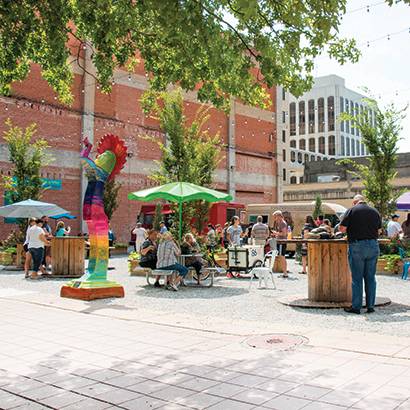
Between two buildings in downtown Wichita, Kansas, in a space left vacant because the previous property owner’s development plans fell through, sits the Pop-Up Park. Pop-up parks are usually temporary installations, but this park, which opened in 2015, seems to be one of those that may become a permanent fixture. Its creation was spearheaded by a nonprofit group, called Downtown Wichita, in response to community complaints. What once was considered an eyesore has become a community destination, complete with artwork, seating, planter beds with trees and flowers, event programming and food trucks.
“One of the things that is cool about the Pop-Up Park is we are always changing things up,” says Troy Houtman, director of the City of Wichita Park and Recreation. “We have tested out a new piece of play equipment before placing [it] in a larger park. We have also placed a piano for about four months to let anyone play, and we had a beach with 5 tons of sand brought in. We have hosted many bands and artists to sell their wares.” Also, where there used to be only dirt, there is now plant life that’s home to a thriving population of butterflies and bees.
Although small in size — the Pop-Up Park is roughly 6,000 square feet — these relatively low-cost, low-maintenance parks provide cities with substantial benefits, including the formation of community-gathering spaces and opportunities for citizens to connect with nature. A recent study by the People, Nature, Place research program at Australia’s Royal Melbourne Institute of Technology University’s Centre for Urban Research finds that even small, impermanent green spaces contribute positively to urban biodiversity, supporting the health of humans as well as of urban wildlife.
Many factors — size, location, duration and number and type of features included — can impact the specific social and ecological benefits of pop-up parks. However, they can be a beneficial addition to urban communities in need of more green space.
Lindsay Collins is the Associate Editor for Parks & Recreation magazine

